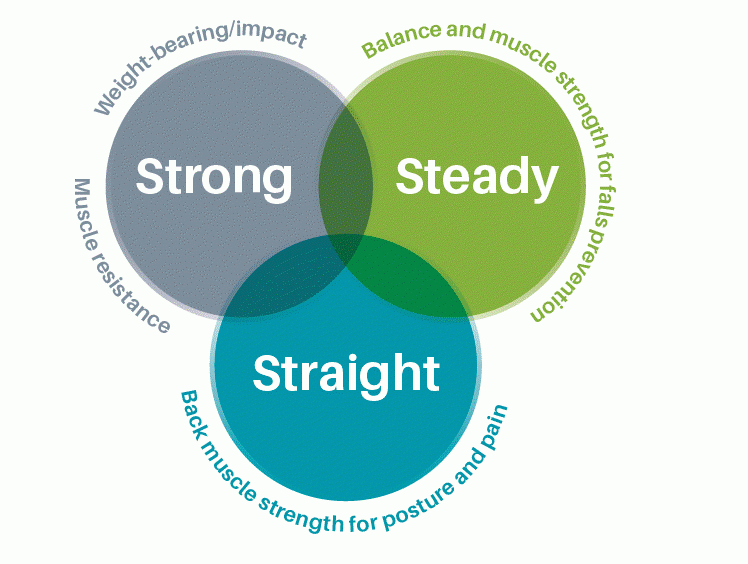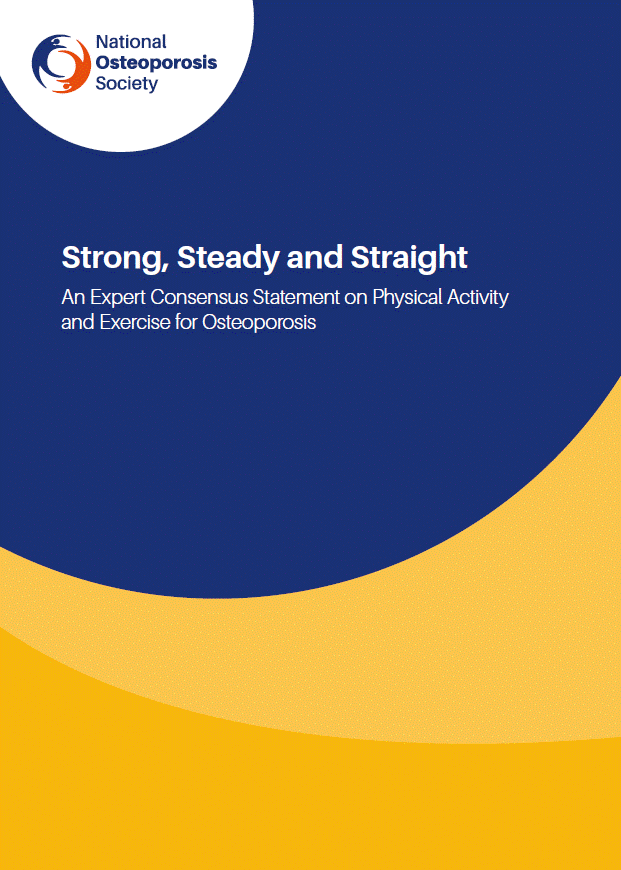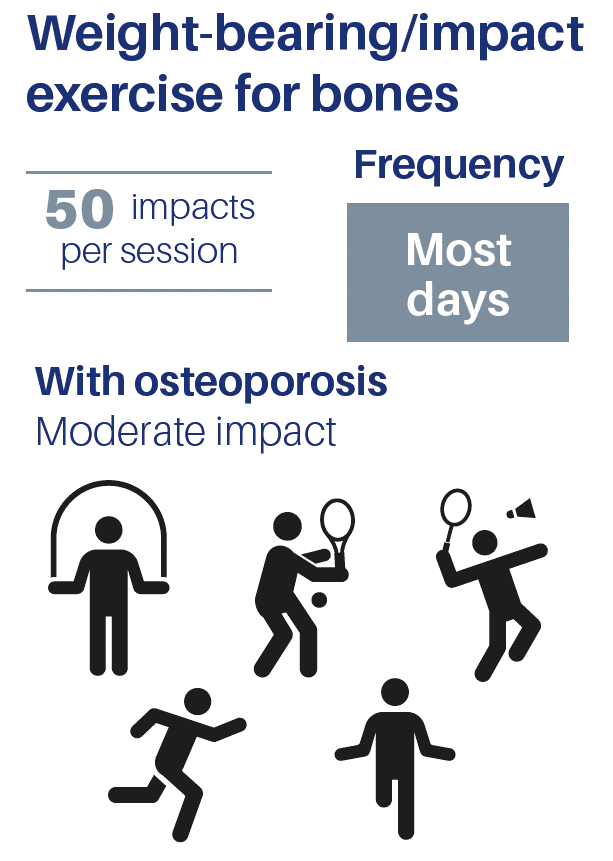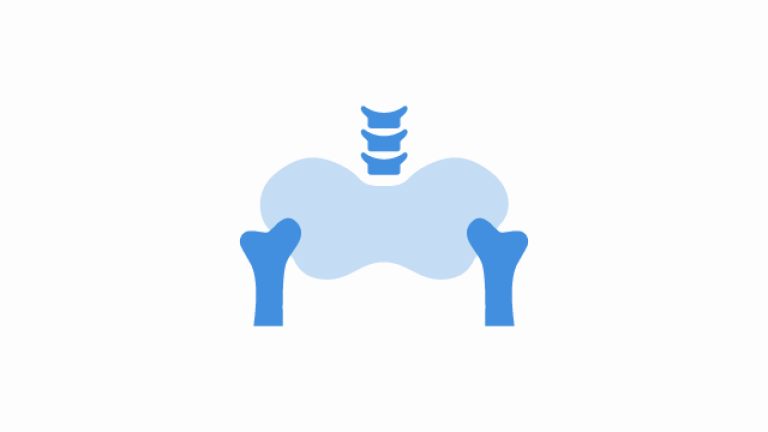Strong, Steady & Straight: NOS Exercise and Osteoporosis Consensus Statement
Strong, Steady and Straight is an expert consensus statement on physical activity and exercise for osteoporosis from the National Osteoporosis Society, supported by the BGS. The background, purpose and principles of the document are outlined below, and the full Consensus Statement and Quick Guide can be downloaded using the links on the right hand side of this page.
Background
Fragility or osteoporotic fractures are common, especially in older age, and have a huge personal impact and economic cost to society. Fragility fractures cost the NHS an estimated £4.4 billion per annum.
For the individual, these fractures, especially in the hip and spine, can lead to loss of independence, disability and reduced life expectancy. Vertebral fractures in particular are associated with long-term pain and other physical and psychological symptoms.
It is widely understood that physical activity and exercise help to make bones strong; however, there is lack of clarity about their role in bone health and the prevention of frailty, and for people with osteoporosis in particular.
| Definition of osteoporosis The term osteoporosis is used throughout this statement as an umbrella term to include someone with low bone mineral density (BMD) in the osteoporosis range (measured using dual X-ray absorptiometry (DXA)) or a significant fracture risk (based on fracture risk assessment) with or without fragility (low trauma) fractures, including vertebral. |
Many guidance documents warn against ‘forwardbending’, high-impact exercise (often interpreted as anything more than brisk walking) and lifting weights. This is based on a theoretically increased risk of vertebral fracture due to increased force through the bones by high-intensity resistance or impact exercise or increased load on the spine. Previous guidance, originally developed for those with vertebral fracture, has been generalized to all people with osteoporosis.3 For some health and exercise professionals, uncertainty around what is appropriate or safe persists, and may be accompanied by concerns about liability. As a result, people with osteoporosis often find the advice provided to be inadequate, confusing, varied or inconsistent.
Even where the evidence is inconclusive, people with osteoporosis are keen to incorporate non-drug approaches and take control of the management of their condition.
People with osteoporosis want to know:
- whether some types of physical activities and exercise interventions are unsafe and may cause fractures, especially in the spine.
- what type of physical activity and exercise they need to do to effectively maintain or improve their bone strength.
- whether and how, they should modify moving, lifting, sports and leisure activities to prevent a vertebral fracture occurring.
- about specific exercise interventions to relieve the pain of painful vertebral fractures.
Without this information, people significantly reduce activity levels, limiting both function and enjoyment. This has adverse implications for their bone health, falls and future fracture risk. In fact, for the vast majority of adults and older adults, taking part in activities that promote muscle and bone strength is safe and will help maintain or improve function, irrespective of age or health.
Giving people confidence about physical activity and exercise for osteoporosis by means of authoritative and effective guidance may also prompt an increase in physical activity and exercise. This will have wider beneficial effects on physical, social and psychological health, wellbeing and self-efficacy.
Purpose and objective
This document is intended for UK medical and allied health professionals, physiotherapists and other exercise professionals.
It was developed by an Expert Group of clinicians, scientists and practitioners from the UK.
The objectives of this document are to:
- clarify the role of physical activity and exercise for bone strength, reducing falls and fracture risk reduction. The focus is on information relevant for those with osteoporosis, although most principles will also be appropriate in terms of wider ‘prevention’ messages, recognising the importance of physical activity and exercise, together with other lifestyle approaches, to build and maintain bone strength throughout the life course
- explain any safety issues for those with osteoporosis, and especially to address fears of causing fracture (particularly in the spine) whilst engaging in exercise or day-to-day physical activities •• clarify the role of physical activity and exercise to help with the pain and symptoms of vertebral fracture
- promote confidence and a positive approach so that people with osteoporosis do more rather than less exercise and physical activity
- ensure consistent advice for people with osteoporosis so that they exercise safely and effectively.
This document updates the principles underpinning previous guidance on exercise and physical activity and distils current research evidence on the subject. It is designed for UK health and exercise referral systems. It integrates as far as possible with broader UK Chief Medical Officer (CMO) recommendations about physical activity for health.
| Physical activity | Exercise |
| Refers to any bodily movement produced by skeletal muscles that results in energy expenditure. This can be anything from walking to the shops, taking part in activities of daily living such as gardening, or taking part in occasional leisure or sporting activities. |
Defined as physical activity that is
|
This document supplements existing UK clinical guidance with regard to the role of physical activity and exercise in osteoporosis management. It endorses the current clinical approach to osteoporosis management – that physical activity and exercise should complement rather than replace the use of pharmacological therapies recommended to improve bone strength for those with a significant fracture risk.
Using this document
This document is structured around three themes for physical activity and exercise for osteoporosis – Strong, Steady & Straight (Figure 1). Recommendations are specified under each theme, where appropriate, for:
- all people with osteoporosis
- people with vertebral fractures or multiple low-trauma fractures
- people who are frail and unsteady or those experiencing falls.
Individual themes will have particular relevance for some individuals according to their needs or preferences, but all are important and should be considered.
| Recommendations are made in each section based on either the evidence reviewed, marked E; or expert consensus, marked C, where limited or no research evidence was available. |
Executive Summary
Principles
|
Physical activity and exercise have an important role in the management of osteoporosis, promoting bone strength, reducing falls risk, and the management of vertebral fracture symptoms. They should form part of a broad approach that includes other positive lifestyle changes, combined with pharmacological treatment where appropriate. |
|
People with osteoporosis should be encouraged to do more rather than less. This requires professionals to adopt a positive and encouraging approach, focusing on ‘how to’ messages rather than ‘don’t do’. Although specific levels and types of physical activity and exercise are likely to be most effective, even a minimal increase in activity should be encouraged to provide at least some benefit. |
|
The evidence indicates that physical activity and exercise is not associated with significant harm, including vertebral fracture; in general, the benefits of physical activity and exercise outweigh the potential risks. |
|
Professionals should avoid restricting physical activity and exercise unnecessarily according to BMD or fracture risk thresholds, as this is often unhelpful and may discourage exercise or activities that promote bone as well as other health benefits. |
|
People with painful vertebral fractures need clear and prompt guidance on how to adapt movements involved in day-to-day living, including how exercises can help with posture and pain. Anyone with osteoporosis may benefit from guidance on amending some postures and movements to care for their back. |
About the Royal Osteoporosis Society
The National Osteoporosis Society became the Royal Osteoporosis Society in February 2019. Their aim is to provide information, support and networks for people living with osteoporosis, and work with healthcare systems to improve diagnosis and care. Follow the link below to find out more about the ROS.
About the Royal Osteoporosis Society
The National Osteoporosis Society became the Royal Osteoporosis Society in February 2019. Their aim is to provide information, support and networks for people living with osteoporosis, and work with healthcare systems to improve diagnosis and care. Follow the link below to find out more about the ROS.



